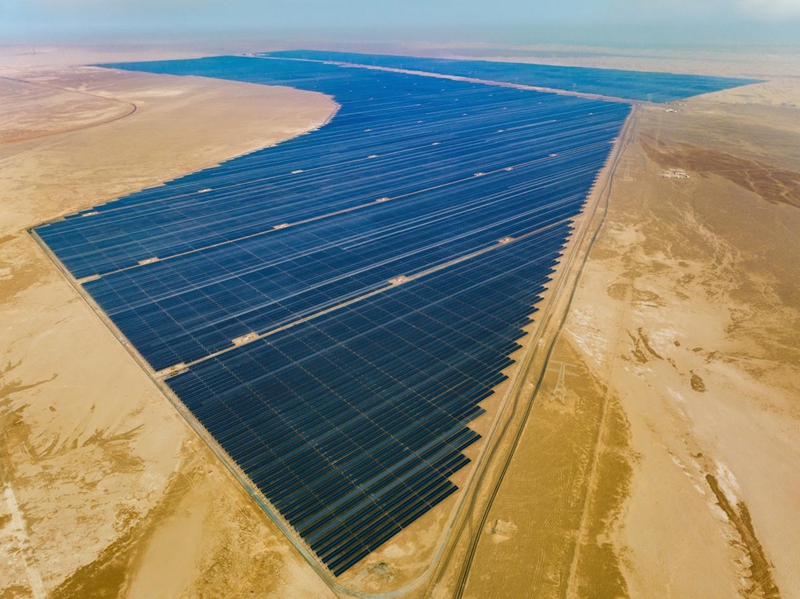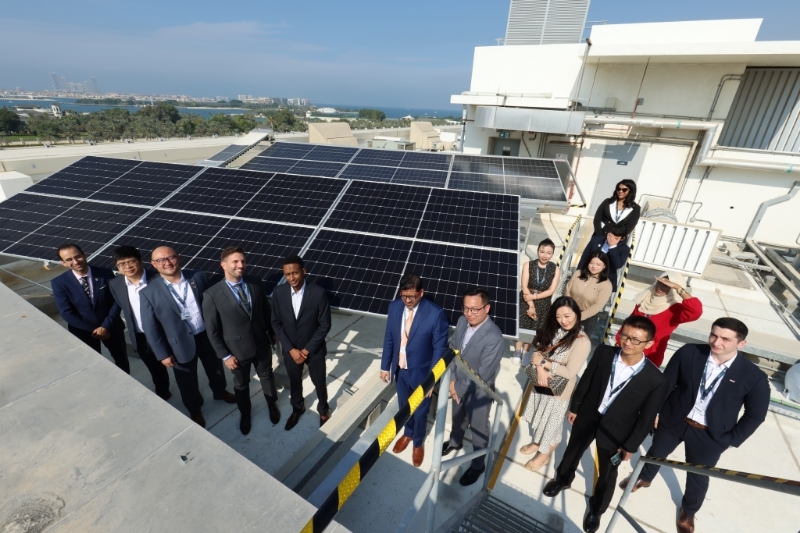Chinese PV leaders strive to be the lightchaser in the Middle East desert
by Wu Siya
DUBAI, Sept. 16 (China Economic Net) - About 65 kilometers south of downtown Dubai, in the heart of the vast desert, a 262-meter-high solar tower stands tall. Below the tower, a field of about 70,000 heliostats extends radially around, gathering sunlight from all directions onto the collector at the top of the tower.

The fourth phase of the Mohammed bin Rashid Al Maktoum Solar Park [Photo/ Shanghai Electric Group]
This is the fourth phase of the Mohammed bin Rashid Al Maktoum Solar Park, as well as a key project jointly built by China and the UAE under the Belt and Road Initiative. In 2018, Shanghai Electric Group Co., Ltd. undertook the project, with a total installed capacity of 950 megawatts. In February this year, all generators were connected to the grid and put into commercial operation, with a cumulative power generation of 3.5 billion kWh.
“It could supply green electricity to about 320,000 local households and reduce carbon dioxide emissions by more than 1.6 million tons each year,” Omar Hassan, executive director of the project, introduced.
On the other side, in the desert about 45 kilometers south of Abu Dhabi, lies the Al Dhafra Solar Project built by China Machinery Engineering Corporation (CMEC). The endless blue photovoltaic panels spread out like a huge metal carpet, interweaving with the golden sand dunes to form a spectacular scene, which is also the world’s largest single photovoltaic power station that has been built so far.
“With an installed capacity of 2.1 GW, our power generation could meet the needs of about 200,000 households in the UAE, reducing carbon emissions by more than 2.4 million tons per year, and increasing the proportion of clean energy in the UAE’s total energy structure to more than 13%," said Wang Jinwei, the project leader. “The UAE has extensive deserts and abundant sunshine all year round, making photovoltaic power generation the most ideal alternative for the country’s clean energy transformation.”

The Al Dhafra Solar Project [Photo/CMEC]
Facing a series of energy challenges, the Gulf countries, whose economies are mainly based on traditional energy, are actively seeking a cleaner transition. The UAE has launched a number of photovoltaic projects in recent years, and it is expected that by 2025, the country’s photovoltaic installed capacity will reach 8.5 GW. From the perspective of resources, the UAE’s annual total solar irradiance is 7,920 MJ/m2. In contrast, the annual solar irradiance in China’s Qinghai-Tibet Plateau and northern Gansu is between 5,040 and 6,300 MJ/m2.
Statistics from the Middle East Solar Energy Industry Association showed that the photovoltaic market in the Middle East and North Africa is currently worth about USD 20 billion. By 2030, the market will be worth USD 1 trillion. In the meantime, the demand for solar energy in the Middle East is also expected to increase from 20.5-23.6 GW in 2023 to 29-35 GW in 2027.
During the International Digital Energy Expo (IDEE) 2024 held in Shenzhen from September 8 to 11, KPMG China released a report titled China’s New Energy Enterprises “Going Abroad” Series: Sailing to Middle East. Alex Choi, ASPAC Regional ENR Leader, KPMG China noted that for a long time, the China-Arab cooperation has gradually formed a 1+2+3 pattern, in which 1 refers to energy cooperation, a priority among priorities. China’s leading photovoltaic companies are also leveraging their technological advantages to assist the Middle East in its green energy transition and have achieved important results in optimizing grid operations.
“From photovoltaics, energy storage to batteries, Chinese technology has demonstrated strong competitiveness and innovation in the Middle East. The Middle East has a keen demand for new energy, as well as China has advanced products and technologies, which definitely means a win-win situation,” Teng da, head of the Middle East and North Africa at LONGi, a global PV leader, told the CEN.

A LONGi PV project in UAE [Photo provided to CEN]
“In 2023, we have opened a photovoltaic tech training center in Dubai and build the first BC experimental power station and PV laboratory in the Middle East. Currently, our industrial, commercial and household distributed PV products are increasingly popular in the Middle East. In the past two years alone, LONGi’s shipments in solar commercial and residential scenarios in the Middle East region have exceeded 2GW, of which the UAE accounts for nearly 50%,” Teng added.
(Editor: fubo )


